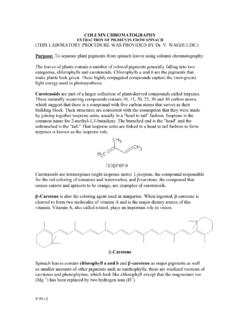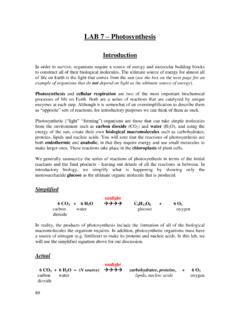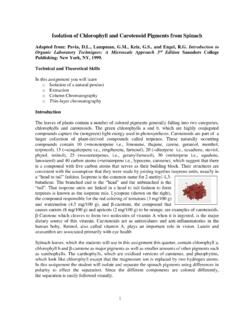Transcription of Plant Pigment Chromatography
1 INQUIRY-BASED ScienceTEACHER S GUIDELife ScienceWhat are the photosynthetic pigments present in my leaf?GRADES 9 12 Plant Pigment Chromatography2 Van Andel Education Institute Investigation is based on the Van Andel Education Institute (VAEI) Instructional Model for Inquiry-Based Science. In all investigations:Life ScienceStudents play a driving role in determining the process for and students construct meaning together by are working as hard as the don t know the answer they are supposed to Pigment ChromatographyWhat are the photosynthetic pigments present in my leaf?Photosynthesis is a critically important biochemical process providing the oxygen required to support respiration in nearly all non-autotrophic organisms on earth.
2 Providing students with an opportunity to explore the chemistry of plants , along with the chemicals used in the process, provides them with a solid foundation for understanding and modeling the biochemical reactions that drive photosynthesis. In this lesson, students use Chromatography to extract the Plant pigments from spinach leaves that are responsible for photosynthetic activity. Understanding that there are different pigments present in plants prepares students for a deeper look at photosynthesis. In the follow-up investigation, Rate of Photosynthesis, students determine how various factors influence the rate of photosynthesis. Grade Level/Content9 12/Life ScienceLesson SummaryThis is the first of two lessons providing students with opportunities to explore how plants utilize energy from the sun to create compounds that store energy.
3 In this lesson, students learn about and investigate the types of Plant Pigment macromolecules used to capture energy from the light reactions of photosynthesis. The second lesson explores the Rate of Time1, 45-minute class periodMaterials Fresh baby spinach leaves (or other available leaves); large test tubes; Chromatography paper; Chromatography solvent (9:1 Petroleum ether and acetone); mortar, pestle, and ethanol (optional); additional Plant structures (roots, stems, fruits, etc.) for optional follow-up investigation; colored pencils; one coin (penny, quarter, etc.); pencil; Investigation Plan; journal; InternetSecondary ResourcesPhotosynthetic PigmentsWhat pigments are in Fruit & Flowers?
4 NGSS ConnectionHS-LS1-5 Use a model to illustrate how photosynthesis transforms light energy into stored chemical Objectives Students will use paper Chromatography to separate photosynthetic pigments found in spinach leaves (or leaves of their own choice). Students will use color differences to identify photosynthetic pigments from their leaves and calculate observed Rf factors. Students will describe the role of photosynthetic pigments in capturing the energy that initiates the light reactions of photosynthesis. 3 2 INVESTIGATION FACILITATIONS tudents capture what they already know about Plant pigments and Plant coloration. Have students identify key components of the investigation question.
5 Ask them to write 3 5 ideas in their journal before sharing them with their table partners. Once ideas are shared, have students record additional ideas from their table partners in their journal. Encourage students to review their list and circle ideas and concepts that they are not sure KnowledgePart 1 INVESTIGATION SETUPC ollect the materials necessary for each student group to perform the investigation. fresh baby spinach leaves (or other available leaves) large test tube Chromatography paper Chromatography solvent (9:1 mixture of Petroleum ether:acetone) colored pencils one coin (penny, quarter, etc.) pencil mortar, pestle, and ethanol (optional method for extracting pigments for application on Chromatography paper) Investigation Plan additional Plant structures (roots, stems, fruits, etc.)
6 For optional follow-up investigation Internet journalWhat are the photosynthetic pigments present in my leaf?Introduce the investigation Chromatography is used to separate mixtures of substances into their components. Paper Chromatography is a technique used to separate and identify Plant pigments . Plant pigments are not equally soluble within the Chromatography solvent. As a result, they will stop at different places as the solvent wicks up the Chromatography paper. Plant pigments are colored molecules that absorb light at specific wavelengths. These molecules capture the energy of sunlight and use it to make their own food. For more information about the different types of Plant pigments , provide this resource (or your own) for students to review: Photosynthetic PigmentsSecondary KnowledgeProvide students with background information about how paper Chromatography works, and why it is used to separate Plant Andel Education Institute 4 Students use paper Chromatography to separate Plant pigments from the spinach Plan Have students work in teams of 2 3.
7 Review the materials and preparations to use paper Chromatography to separate photosynthetic pigments found in leaves. Have students follow the Investigation THINKINGUse the Fair Test checklist to help students think critically about the investigation plan. Help them understand that a good investigation plan must include a test that is repeatable, generates quality data, and minimizes error. The more critically students think about their investigation plan, the more confident they can be in their results. Have students create a data table to record their observations. Students will record the band colors and distances travelled (in cm) for each observed Plant Pigment band, as well as the distance travelled for the Chromatography solvent.
8 Remind students to record qualitative observations for each observed Plant Pigment students observe and record their data, encourage them to consider the mechanics of Chromatography . What carries the chemicals along the paper? Why do some chemicals travel farther than others? What are the advantages and disadvantages of using paper Chromatography to separate chemicals in a mixture? These questions can serve as opportunities for follow-up investigations by student groups or individuals. Providing students with a thinking space to be curious about what is taking place is crucial to creating a classroom where curiosity, creativity, and critical thinking thrive.
9 Students record their | Investigation PlanPlant Pigment ChromatographyVan Andel Education 1. Cut a thin piece of Chromatography paper that will fit in the large test tube and is long enough to extend out the top. (Optional: cut bottom end to form a point.) 2. Using a pencil, draw a line across the paper about 2 cm from the bottom. 3. Place the leaf material on the Chromatography paper using either option a or b:a. Take a baby spinach leaf (or a leaf of your choice) and lay it across the line you drew on the Chromatography paper. Place a coin on its edge and roll it over the leaf on the pencil line to transfer Plant material to the paper.
10 Find a new spot on the leaf and roll the coin across the same pencil line again. Repeat 5 10 times. The line should become a deep green* color. orb. Take some baby spinach leaves (or different leaves of your choice) and cut them up before placing them in a mortar. Add a small amount of ethanol before grinding them with a pestle until there is a deep green* colored liquid. Dip a capillary tube into the green liquid and then cover the top end with your finger. Place one small dot on the pencil line on the Chromatography paper. Let the dot dry. Apply several more layers to the dot or place additional dots to completely cover your pencil line. 4.






